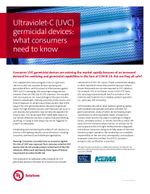
Ultraviolet-C (UVC) Germicidal Devices: What Consumers Need to Know
Understand the risks and benefits of UV lighting, its disinfecting properties and its uses in consumer, commercial and medical settings.

In recent years, the use of ultraviolet-C (UVC) lighting technology for sanitization has expanded into markets including lighting, appliances, healthcare, consumer products and more. It is critically important to certify that these products meet existing safety and performance requirements, especially given that the technology’s applications can include:
UVC (180-280 nm, classified as UVC short-wave) radiation has sanitizing properties and germicidal benefits, depending on exposure dose — which is based on strength, proximity and time. However, there are serious risks to UVC exposure, so it is essential to confirm that eligible UVC devices meet the relevant UL Standards. When the Standard does not include photobiological safety requirements for UVC, standards set by the American Conference of Governmental Industrial Hygienists (ACGIH), ANSI/IES RP-27 and IEC 62471 — which relate to the photobiological safety of lamps and lamp systems — are applied.
Containment is a key concept in UVC design, referring to strategies that direct harmful ultraviolet light exclusively at germs while shielding people from exposure. Consumer-oriented germicidal devices typically achieve containment by enclosing the UVC source within the product housing. In contrast, germicidal devices used by trained professionals in controlled settings may feature exposed UVC sources. For these designs, product and site safeguards — as well as the intended use — are critical factors in evaluation and certification.
| Type of UVC Device | Sample Image | Environment | Assessing the risks | Safety Certification(s) |
Home-use portable sterilizer Marketed to clean a room in the home, with or without a timer | Consumer | Portable equipment with uncontained UV source. UV overexposure risk is addressed via integral safeguards;
| UL 8803 Outline of Investigation IEC 62471 for photobiological assessment | |
| Personal portable sterilizer/wand Marketed to be handheld and moved over surfaces to sterilize |  | Consumer | UVC is NOT contained — it may produce ozone. Device may be used by untrained persons unfamiliar with the risks involved. There is a risk that people and pets could accidentally be exposed to UVC and be injured, and ozone may be emitted. The exposure dose to people can be far above acceptable levels and can cause injury. Integral timers or proximity and orientation sensors pose concerns with accuracy and reliability of these safeguards as well as opportunities for misuse or bypass. Stationary (non-handheld) products for use in an unoccupied area with specific safeguards may have a path to safety certification. | NOT eligible for certification for consumer use; for medical and professional applications, contact UL Solutions to discuss. |
| Home-use air cleaners with internal (contained) UVC Marketed to homes and offices |  | Consumer | UVC is contained The UVC source is inside the product enclosure and a safeguard disables the UVC when an access door is opened. | UL 507 for electrical investigation; standard includes personal injury requirements for UVC based on ANSI RP-27 for photobiological assessment. |
| Portable UVC sterilization box Marketed to clean cell phones, small personal devices |  | Consumer and Commercial | UVC is contained The UVC source is inside the enclosure; opening the door will disable the UV source. Testing would ensure that any UV “leakage” will be within safe exposure dose limits. | UL 73 for electrical investigation; standard includes personal injury requirements for UVC based on ANSI RP-27 for photobiological assessment. |
| Upper room (UVGI) Mounted out of easy reach, typically 2.3 m (7 feet) from floor |  | Commercial | Permanently mounted, i.e., fixed, equipment intended to be installed and operated in non-residential locations. UVC containment is achieved based on product design features, plus site safeguards. | UL 8802 IEC 62471 for photobiological assessment |
| Commercial/industrial heating and ventilation May also be found in home settings |  | Commercial | UVC is contained inside the air duct and not visible Access is restricted to qualified personnel during installation and service. The design also includes other product safeguards such as ON/OFF switch and interlock switch | UL 1598 (or UL 153) and UL 1995 for electrical investigation; UL 1995 includes personal injury requirements for UVC based on ANSI/IES RP-27 for photobiological assessment |
| Water treatment plants UVC disinfects the water as an alternative to chlorination |  | Commercial | UVC is contained inside a water vessel and not visible Access is restricted to qualified personnel during installation and service. | UL 979 for water treatment equipment ANSI RP-27 for photobiological assessment |
| Equipment sterilization Sterilizing robots Used in hospital operating rooms as a secondary tool for disinfection |
| Healthcare and Commercial | UVC containment is achieved by limiting access to the space so people are not present during disinfection. In addition, the equipment includes reliable safeguards and is operated by staff with training for its proper use. | In healthcare facility and laboratory settings – UL 61010 for electrical investigation; the standard references IEC 62471 for photobiological assessment to address personal injury concerns for UVC. In commercial settings – UL 73 for electrical investigation; standard includes personal injury requirements for UVC based on ANSI/IES RP-27 for photobiological assessment. |
| Germicidal systems (may have regular lights in addition to UV emitters) |  | Healthcare and Commercial | Permanently mounted, i.e., fixed, equipment intended to be installed and operated in non-residential locations. UVC containment is achieved based on product safeguards, trained staff and site safeguards. | UL 8802 IEC 62471 for photobiological assessment |
| UV Lamps and Components (Ballasts, LED drivers, UV light sources, Controls & Sensors) |  | Components | Components for use in UVC equipment and germicidal systems; contact UL Solutions to discuss the specific use and design as well as the intended operation, e.g., within luminaires or only within equipment designed specifically for germicidal applications. | Various, as applicable |

Ultraviolet-C (UVC) Germicidal Devices: What Consumers Need to Know
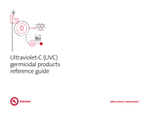
UVC Germicidal Products Reference Guide
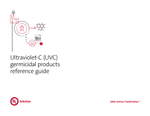
UVC Germicidal Products Reference Guide for Consumers
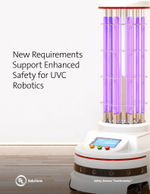
New Requirements Support Enhanced Safety for UVC Robotics

UL 8802, the Standard for UV Germicidal Equipment and Systems

UL 8803, OOI for Portable UV Germicidal Equipment
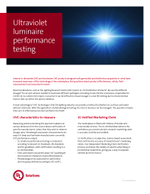
Ultraviolet (UV) Luminaire Performance Testing

Lighting for Sanitation
Have questions, need specifics? Let's get this conversation started.